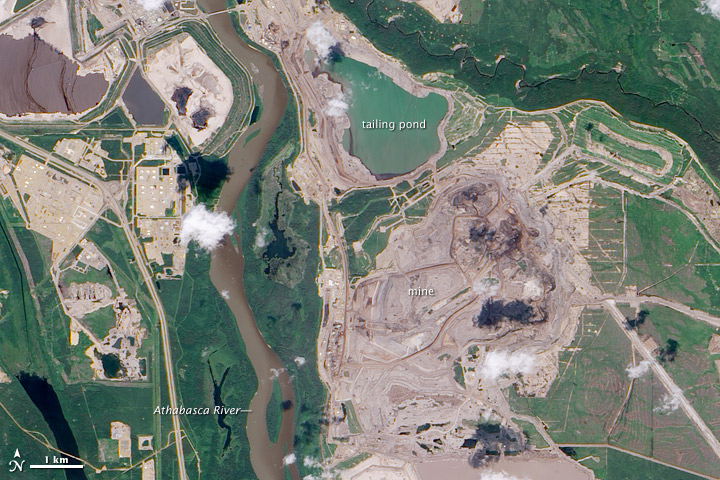Despite the fact that U.S. produces enough crude oil to meet most of our energy needs, we still import more than 6 million barrels of heavy crude oil per day. In this episode we explore heavy oil and why we still import so much of it.
Be sure to also subscribe on Apple Podcasts via the link above and please leave us an honest rating and review. We read every one of them and sincerely appreciate any feedback you have. To ask us a question to be featured on an upcoming episode, please leave a comment below or send an email to feedback@mineralrightspodcast.com.
What is Heavy Oil?
According to Wikipedia, “Heavy crude oil (or extra heavy crude oil) is highly-viscous oil that cannot easily flow from production wells under normal reservoir conditions. It is referred to as “heavy” because its density or specific gravity is higher than that of light crude oil. Heavy crude oil has been defined as any liquid petroleum with an API gravity less than 20°. Physical properties that differ between heavy crude oils and lighter grades include higher viscosity and specific gravity, as well as higher molecular weight hydrocarbon composition.”
Heavy oil is related to bitumen from oil sands or tar sands. Oil sands are considered “extra-heavy oil” since it has an API gravity of less than 10. This means it is more dense than other grades of crude oil. These super dense and viscous forms of heavy crude oil often will not flow under ambient conditions. Think of it like really cold molasses.
How is Heavy Oil Produced?
In order to get heavy oil to flow, it either needs to be heated up or diluted with a less viscous solvent.
Some of the most common production technologies used in heavy oil are:
- Cyclic steam stimulation (huff ‘n’ puff). This is the alternating injection of steam into a wellbore and then the production of oil with the condensed steam. The way this works is steam is injected down hole, then tduring the soak period, the well is shut in for several of days to allow for the formation to heat up to reduce the viscosity of the oil, and finally the oil is produced through the same well until it tapers off. The process is then repeated.
- Steam flooding – A type of steam flood is Steam-assisted gravity drainage or SAG D. This is where two horizontal wells are drilled right on top of each other. The top well has steam continuously injected into it and the bottom well takes the heated up heavy oil and produces it to the surface.
- Wet or dry combustion with air or oxygen injection – this is essentially burning the heavy oil underground to heat up the formation to allow the oil to flow. The fancy term for this is in-situ combustion Similar to SAGD, there might be an upper wellbore where air is injected and hydrocarbon vapors are combusted which heats the oil and allows it to flow down into a producer well.
How Is Heavy Oil Transported?
- Over short distances, operators Increase the temperature to allow it to flow through the pipe from the formation, but at some point the oil cools down to where it becomes to viscous and becomes difficult to pump. To solve this problem, the heavy oil can be diluted with a lighter less-viscous hydrocarbon like natural gas condensate. This is called a diluent. Dilution is one of the most common methods of decreasing the viscosity to allow it to be pumped through a pipeline.
- Other methods that are being explored include using water and surfactants to emulsify the oil to reduce the viscosity or to use drag reducing additives to reduce the friction to make it possible to pump the heavy oil.
Why Do We Still Import Heavy Oil?
According to the EIA, “the physical characteristics of crude oil determine how refineries process it. In simple terms, crude oils are classified by density (API gravity) and sulfur content. Less dense (lighter) crude oils (with higher API gravity) generally have a larger share of light hydrocarbons. Refineries can produce high-value products such as gasoline, diesel fuel, and jet fuel from light crude oil with simple distillation. When refineries use simple distillation on denser (heavier) crude oils (with lower API gravity), they produce low-value products. Heavy crude oils require additional, more expensive processing to produce high-value products. Some crude oils also have a high sulfur content, which is an undesirable characteristic in both processing and product quality.”
According to another EIA report, in 2021 “the United States exported about 8.54 million barrels per day (b/d) and imported about 8.47 million b/d of petroleum, making the United States an annual total petroleum net exporter for the second year in a row since at least 1949. Also in 2021, the United States produced about 18.77 million b/d of petroleum and consumed about 19.89 million b/d.”
That report also mentions that “The United States remained a net crude oil importer in 2021, importing about 6.11 million b/d of crude oil and exporting about 2.96 million b/d. However, some of the crude oil that the U.S. imports is refined by U.S. refineries into petroleum products—such as gasoline, heating oil, diesel fuel, and jet fuel—that the U.S. exports.”
Top Four Heavy Oil Imports
- The US imported over 1,369,141,000 barrels of heavy oil in 2021 and here are the top 4 countries we imported from:
- 1) Canada – 1,028,114,000 (75.1% of imports)
- 2) Mexico – 158,378,000 (11.6% of imports)
- 3) Colombia – 63,532,000 (4.6% of imports)
- 4) Ecuador – 52,591,000 (3.8%)
Before the latest round of sanctions went into effect, the we used to import as much oil from Venezuela as we do from mexico, in fact as recently as 2016, we imported 267 million barrels from Venezuela and that year we imported 207 million barrels from Mexico so it was solidly the #2 country we imported heavy crude oil from.
Why Do We Import So Much Heavy Oil?
The answer is due to two reasons. The first reason is our refineries were designed to process certain blends of crude oil and those decisions were made several decades ago and certainly before the shale revolution.
The majority of the shale formations and plays that have been developed since the 2010’s produce light sweet crude oil. At the same time, many of our refineries are designed to process heavier crude oil which historically has traded at a discount to Brent or WTI. For example, the Shell Deer Park Refinery is designed to process heavy Mayan crude oil imported from Mexico. “Maya is a heavy crude oil with an API specific gravity between 21 and 22 degrees, meaning only the most sophisticated refineries are capable of profitably processing it.” (Reuters) In the case of the Deer Park Refinery, Shell and Pemex (Mexico’s state owned oil company) have a long-term JV to process Mayan Crude.
According to RBN Energy, “The deal was inked in 1993, when Pemex paid $1 billion for a 50% stake in the now 340-Mb/d refinery located along the Houston Ship Channel about 20 miles east of Houston. As a result of this investment, Pemex secured a major U.S. customer for its Maya crude at a time when few refineries had the expensive technology needed to extract full value from such a heavy-sour grade. “
This particular agreement allows Shell to have a steady supply of crude oil for its products and in exchange, Mexico has a place to send this lower grade crude oil. With sanctions against Venezuela over the past several years, this eliminates the geopolitical risk with having to try to find heavy crude oil from other countries that might face sanctions.
But, let’s get back to the question of why we import more than 6 million b/d of heavy oil. The other reason I alluded to is because refineries make a certain amount of each refined product from a barrel of crude oil. We’ve mentioned it on the show before but the rule of thumb, sometimes referred to as the crack spread, is for every 3 barrels of crude oil, 2 barrels of gasoline and 1 barrel of distillates like diesel are produced. With middle distillates like diesel and jet fuel accounting for most of the growth in oil demand, and the fact that light crudes aren’t ideal for making these products, we still have continued demand for heavier blends of crude oil in order to meet the demand for diesel and jet fuel.
Summary
So to summarize, heavy crude oil is oil that has a higher density and an API gravity less than 20. The top 5 producers of heavy crude oil in order are Canada, Venezuela, Brazil, Iraq and Mexico. In general, heavy crude oil is more expensive to produce and transport than light crude oil and as a result, it usually trades at a discount to the Brent and West Texas Intermediate benchmarks.
Resources Mentioned in This Episode
- America Produces Enough Oil to Meet Its Needs, So Why Do We Import Crude? | Nasdaq
- Why the U.S. Must Import and Export Oil
- Heavy Oil — Sources — Student Energy
- Heavy crude oil – Wikipedia
- Heavy oil – PetroWiki
- Refining crude oil – inputs and outputs – U.S. Energy Information Administration (EIA)
- Top heavy crude producers globally
- Let’s Stay Together, Part 2 – Pemex and Shell Renew Their Deer Park Vows, With a Twist | RBN Energy
- U.S. Looks to Ease Venezuela Sanctions, Enabling Chevron to Pump Oil – WSJ
Thanks for Listening!
To share your thoughts:
- Leave a comment or question below (we read each one and your question may be featured in a future episode)!
- Ask a question or leave us feedback via email.
To help out the show:
Click the Apple Podcasts Logo Above to leave us a rating & review. It really helps us reach those that need to hear this information and only takes a minute. We greatly appreciate it! Plus, you can get a shout out on a future episode!
Thanks again – until next time!



